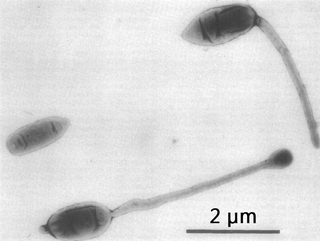
The Campylobacterales are an order of Campylobacterota which make up the epsilon subdivision, together with the small family Nautiliaceae. They are Gram-negative. Most of the species are microaerophilic.
Pedomicrobium is a ubiquitous bacterium dominant in biofilms of man-made aquatic environments such as water distribution systems and bioreactors. Due to their abilities to oxidise manganese (Mn), they are found to be the main culprits of Mn related “dirty water”.
In taxonomy, Hyphomonas is a genus of the Hyphomonadaceae.

Allium aflatunense is a species of plant in the amaryllis family, native to Kazakhstan and Kyrgyzstan in Central Asia. In other regions, it is commonly grown as a garden plant.
Dimethyl-sulfide monooxygenase (EC 1.14.13.131, dimethylsulfide monooxygenase) is an enzyme with systematic name dimethyl sulfide,NADH:oxygen oxidoreductase. This enzyme catalyses the following chemical reaction

Allium hollandicum, the Persian onion or Dutch garlic, is a species of flowering plant native to Iran and Kyrgyzstan but widely cultivated as an ornamental because of its umbels of attractive purple flowers. It is reportedly naturalized in Saint Louis County, Minnesota.

Hyphomicrobium is a genus of Gram-negative, non-spore-forming, rod-shaped bacteria from the family of Hyphomicrobiaceae. It has a large polar or sub-polar filiform prostheca very similar to that of Caulobacter. In addition to having a nutritional function, the prostheca also plays a role in the initiation of DNA replication.
Hyphomicrobium aestuarii is a Gram-negative bacteria from the genus of Hyphomicrobium.
Hyphomicrobium chloromethanicum is an aerobic, methylotrophic bacteria from the genus of Hyphomicrobium which can utilize chloromethane as the only source of carbon.
Hyphomicrobium coagulans is a Gram-negative, non-spore-forming, methylotrophic bacteria from the genus of Hyphomicrobium.
Hyphomicrobium denitrificans is a bacterium from the genus of Hyphomicrobium which was isolated from the Netherlands.
Hyphomicrobium facile is a bacterium from the genus of Hyphomicrobium which was isolated from soil in New Hampshire in the United States.
Hyphomicrobium methylovorum is a bacterium from the genus of Hyphomicrobium which was isolated from soil samples in Japan.
Hyphomicrobium nitrativorans is a bacterium from the genus of Hyphomicrobium which was isolated from biofilm at the Montreal Biodome in Canada.
Hyphomicrobium sulfonivorans is a bacterium from the genus of Hyphomicrobium which was isolated from garden soil in Warwickshire in England.
Hyphomicrobium vulgare is a bacterium from the genus of Hyphomicrobium.
Hyphomicrobium zavarzinii is a bacterium from the genus of Hyphomicrobium which was isolated from swampy soil in Moscow in Russia
Phycisphaeraceae is a family of bacteria.

The Micrococcales are an order of bacteria in the phylum Actinomycetota.
The Rhodothermales are an order of bacteria.




